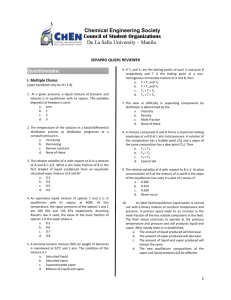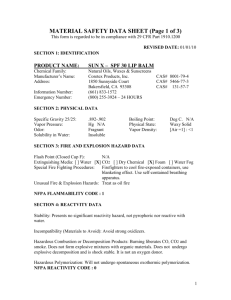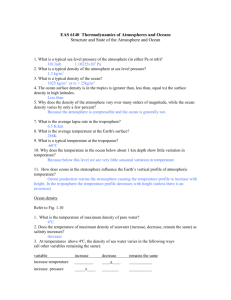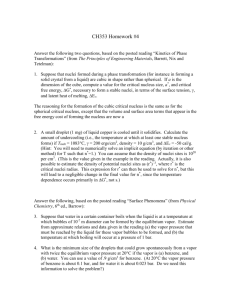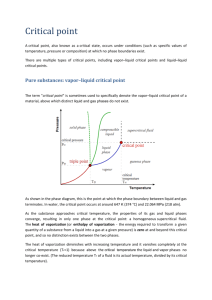doc
advertisement
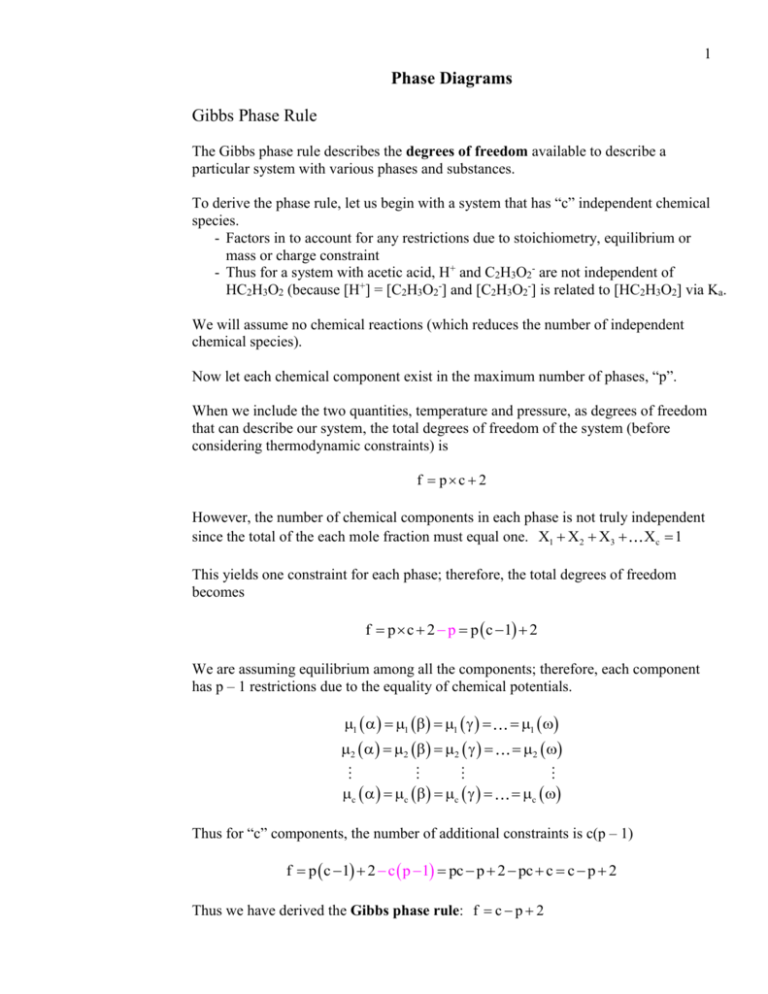
1
Phase Diagrams
Gibbs Phase Rule
The Gibbs phase rule describes the degrees of freedom available to describe a
particular system with various phases and substances.
To derive the phase rule, let us begin with a system that has “c” independent chemical
species.
- Factors in to account for any restrictions due to stoichiometry, equilibrium or
mass or charge constraint
- Thus for a system with acetic acid, H+ and C2H3O2- are not independent of
HC2H3O2 (because [H+] = [C2H3O2-] and [C2H3O2-] is related to [HC2H3O2] via Ka.
We will assume no chemical reactions (which reduces the number of independent
chemical species).
Now let each chemical component exist in the maximum number of phases, “p”.
When we include the two quantities, temperature and pressure, as degrees of freedom
that can describe our system, the total degrees of freedom of the system (before
considering thermodynamic constraints) is
f pc 2
However, the number of chemical components in each phase is not truly independent
since the total of the each mole fraction must equal one. X1 X2 X3 Xc 1
This yields one constraint for each phase; therefore, the total degrees of freedom
becomes
f p c 2 p p c 1 2
We are assuming equilibrium among all the components; therefore, each component
has p – 1 restrictions due to the equality of chemical potentials.
1 1 1
1
2 2 2
2
c c c
c
Thus for “c” components, the number of additional constraints is c(p – 1)
f p c 1 2 c p 1 pc p 2 pc c c p 2
Thus we have derived the Gibbs phase rule: f c p 2
2
Consider the degrees of freedom on a one-component phase diagram,
that is, where “c” = 1
p
solid
triple point
liquid
phase boundary
gas
T
Within each phase region, “p” = 1; therefore, according to the Gibbs phase rule, the
number of degrees of freedom that can be used to describe the system is 2.
f c p 2 11 2 2
In this case the degrees of freedom correspond to the temperature and pressure. As an
example, consider a solid. Within the solid region, the temperature and pressure can
change without changing the phase or composition of the solid: the solid has two
degrees of freedom.
Along a phase boundary, two phases are in equilibrium, that is, “p” = 2. Therefore,
the degrees of freedom is reduced to one.
f c p 2 1 2 2 1
Consider the gas-liquid boundary. When the gas and liquid are in equilibrium,
changing the temperature forces a change in the pressure (if the gas and liquid are to
remain in equilibrium!). Another perspective would be that boiling points are not
independent of pressure or that the boiling points are a function of pressure. (If
pressure is a degree of freedom, then temperature is not.)
Finally consider the triple point, where “p” = 3. Then the degrees of freedom reduced
to zero.
f c p 2 1 3 2 0
The triple point has no freedom. It has a specific pressure and a specific temperature.
Changing either makes our system go away from the triple point.
Can four phases exist together (as in two solid phases, a liquid phase and the gaseous
phase? No!! f c p 2 1 4 2 1 Having -1 degrees of freedom is
meaningless. No “quartic points” are possible.
3
Two-component Liquid-Vapor Phase Diagrams
isopleth
T
Tb (A)
dew point curve
tie line
vapor
vapor + liquid
bubble point curve
Tb(B)
liquid
0
1
ZA
isopleth – a line of constant composition (vertical line when “x”-axis is mole fraction)
dew point curve – boundary between the vapor phase and the vapor + liquid phases
bubble point curve – boundary between the liquid phase and the vapor + liquid phases
tie line – horizontal line that connects the dew point curve and the bubble point curve
with the vapor + liquid phase region
T
Tb (A)
{
{
vapor
{
xA, xB – mole fractions in liquid phase
yA, yB – mole fractions in vapor phase
zA, zB – total mole fractions in both phases
Tb(B)
liquid
zA
0
zA
xA 1
4
Lever rule
T
Tb (A)
{
{
vapor
{
Lever rule – useful technique to that aids in the relative amount of vapor and liquid
and the composition of the vapor and the composition of the vapor
Tb(B)
liquid
zA
0
xA 1
zA
The ratio of vapor amount to liquid amount is the same as the ratio of the lengths on
the tie line. That is the length of the line segment to the right of zA is proportional to
the amount of vapor and the length of the line segment to the left of zA is proportional
to the amount of liquid.
n vap
n liq
x A zA
zA yA
Alternately we have in terms of mole fraction of vapor and mole fraction of liquid,
X vap
x A zA
z yA
and X liq A
.
x A yA
x A yA
The composition of the vapor is found where the tie line meets the bubble point line
and the composition of the liquid is found where the tie line meets the dew point line.
5
Brief derivation of lever rule
The total amount of component A, zAn, is the sum of the amount of Avap and Aliq.
z A n n liq x A n vap y A
However, the total amount of both components is the sum of the amount of liquid and
the amount of vapor.
n n liq n vap
And the total amount of component A is zAn.
z A n n liq z A n vap z A
Equating both expressions yields the lever rule.
n liq z A n vap z A n liq x A n vap y A
n liq z A n liq x A n vap y A n vap z A
n liq z A x A n vap y A z A
n vap
n liq
zA x A
yA zA
6
Total vapor pressure of a mixture of two volatile liquids
Total vapor pressure as function of liquid mole fraction
Consider that the total vapor pressure above a solution comes from component A and
component B (assuming that Raoult’s law is valid for both components). (Remember
xA is the mole fraction in the liquid phase.)
p pA pB x A p*A x Bp*B x A p*A 1 x A p*B p*B x A p*A p*B
Total vapor pressure as function of vapor mole fraction
The mole fraction of the components in the vapor phase can be written in terms of the
mole fractions in the liquid phase, assuming Raoult’s law.
yA
pA
x A p*A
p*A
*
x
A *
*
*
*
p pB x A pA pB
pB 1 x A x A pA
yB
pB
1 yA
p
To avoid issues like negative pressures and mole fractions let us, without loss of
generality, assume that A is more volatile than B, that is, p*B p*A .
If so, then y A y B
x A p*A
yA *
y A p*B y A x A p*A p*B x A p*A
*
*
pB x A pA pB
yA p*B x A p*A yA p*A p*B yA
xA
p
y A p*B
*
A
y A p*B p*A
7
The total pressure in the vapor phase can be written in terms of the pure vapor
pressures and the mole fraction of component A in the vapor phase.
p x A p*A 1 x A p*B p*B x A p*A p*B
p*B p*A p*A p*B y A p*A p*B p*B y A
p*A p*B p*B y A
pp *
p A p*A p*B y A
p*A p*A p*B y A
p*B p*A p*A p*B y A p*B p*B y A p*A p*B y A p*B p*B y A
p*B p*A
p*A p*A p*B y A
p*A p*A p*B y A
*
B
8
Distillation
Fractional distillation
T
Tb (A)
Tb (B)
1
0
zA
The goal of distillation is to purify a one-phase mixture of liquids. The purification is
possible when the two pure liquids have different vapor pressures (that is different
boiling points). When the mixture boils, the vapor has a greater mole fraction of the
more volatile liquid than the mole fraction of the liquid, that is, yA > xA. The
enriched vapor is condensed and boiled (at higher temperature) to further enrich the
vapor with the more volatile component.
Thus the goal of making a liquid with a specific purity is a multi-step process which
is called fractional distillation. The number of distillation steps (vaporization
followed by condensation) needed to complete a separation of liquids is also called
the number of theoretical plates. (The diagram above has 3 theoretical plates
shown.) Assuming without loss of generally that pA* > pB*, the greater the ratio
between pA* and pB*, the fewer theoretical plates are needed for a separation.
Steam distillation
Some liquids (such as essential oils and other fragrances) have decomposition
temperatures below their boiling points. Thus fractional distillation is ineffective in
purifying such liquids. Steam distillation starts differently than fractional distillation
in that the mixture of liquids in immiscible (ideally) rather than miscible.
9
The boiling of the mixture occurs when the total vapor pressure equals the
atmospheric pressure. The total vapor pressure can be considered to come from each
component separately, i. e., p p*A p*B Since the total vapor pressure is greater than
the vapor pressure of either component, the boiling will occur below the boiling point
of either pure component. The condensate of steam distillation has the composition
of the vapor.
p*
yA * A *
pA pB
Thus for oils of low volatility, the distillate has a very small mole fraction.
Azeotropes
Tb(azeo)
Tb(A)
T
vapor
Tb(B)
0
ZA
xaze o
1
In some mixtures, the bubble point line touches the dew point at a specific
composition. When such a composition boils, the composition of the vapor is same
as the composition of the liquid, that is xA = yA. This composition is called the
azeotropic composition and the mixture is said to have an azeotrope.
Azeotropes often limit the degree of purification that a mixture can undergo via
fractional distillation. For example, a mixture of water and ethanol has an azeotrope
at 95% volume percent ethanol (95.6% weight%, 0.896 mole fraction). Thus the
maximum purity that a mixture of ethanol and water can achieve via distillation is
95% (or 190 proof). To make “absolute ethanol”, a drying agent (such as anhydrous
calcium chloride) must be added to remove the water or another substance must be
added to make a tertiary mixture without an azeotrope (such as benzene).
10
Liquid-vapor phase diagram with immiscible liquid phase
The previous liquid-vapor phase diagrams have had liquid phases where the two
liquids have been miscible in each other in all proportional. We need to consider the
possibility that the two liquids have limited solubilities in each other.
vapor
vapor+A
vapor+B
B
A
immiscible
A+B
0
XA
1
In the diagram above, the two-phase liquid portion (immiscible) connects with the
dew point curve of the liquid-vapor portion. Within the two-phase liquid region, two
solutions exist, one that is mostly A with a small amount of B impurity (labeled A)
and one that is mostly B with a small amount of A impurity (labeled B) The
composition of the solutions and the relative amount of each solution can be
determined with a tie line and the lever rule.
Use of a tie line and the lever rule can be used in any two phase region in the diagram
(or any phase diagram!) such as the “vapor + A” region or the “vapor + A” region.
11
Two-component Liquid-Liquid Phase Diagrams
In the above phase diagram, the two-phase liquid region had contact with the liquidvapor region. In mixtures where the two regions do not make contact, the liquidliquid phase diagram can be studied separately from the liquid-vapor phase diagram.
T(K)
Tu c
292
one liquid
phase
two liquid
phases
273
0
1
Xn itrob en zene
In some mixtures, the liquids are miscible above a critical temperature. This critical
temperature is called an upper consulate temperature. An example of such is
mixture is nitrobenzene with hexane.
T(K)
310
two liquid
phases
one liquid
phase
Tlc
291
0
Xtriethylamine
1
In other mixtures, the liquids are miscible below a critical temperature. This critical
temperature is called a lower consulate temperature. An example of such is
mixture is triethylamine with water.
12
T(K)
Tuc
483
one liquid
phase
two liquid
phases
334
Tlc
0
one liquid
phase
Xn icotine
1
Rarely some mixtures have both an upper consulate temperature and a lower
consulate temperature. An example is nicotine in water (in a pressurized system).
13
Two-component Liquid-Solid Phase Diagrams
Simple diagram with eutectic point
liquidus
A simple two-component liquidliquid
solid phase diagram has 4
regions, 2 lines and 1 significant
point.
1. liquid region – one phase Tm (B)
with a miscible mixture
liquid+A
of the two-components
2. liquid + A region – two
liquid+B
phases with solid A with
a liquid enriched with B
3. liquid + B region – two
eutectic point
phases with solid B with
solidus
a liquid enriched with A
A+B
4. solid region – two phases
with solid A mixed with
0
1
XA
solid B
5. The line that indicates the lowest temperatures where only liquid exists is
called the liquidus.
6. The line that indicates the highest temperature where only solid exists is called
the solidus.
The eutectic point (eutektos, Gr. easily melted) yields the temperature where all the
liquid in a mixture must freeze and composition where the composition of the melt
always equals the composition of solid
1. The composition at the eutectic point is known as the eutectic composition.
2. The lowest melting point of solid mixture occurs at the eutectic composition.
3. Once the temperature of a mixture reaches the eutectic point, the temperature
will remain constant until all of the mixture has solidified.
4. Applications of eutectics
A. solder – Sn/Pb (63/37) melts at 183 C
B. fire ceiling sprinklers – Wood’s metal Bi/Pb/Sn/Cd (50.0/26.7/13.3/10)
melts at 70 C
C. emergency escape seals in gas cylinders – Field’s metal Bi/In/Sn
(32.5/51.0/16.5) melts at 62 C, nontoxic alternative to Wood’s metal
D. mercury alternative – Galinstan Ga/In/Sn (68.5/21.5/10.0), used in
thermometers melts at -19 C
E. pharmaceuticals – lidocaine/prilocaine topical anesthetic (eutectic
composition between drug and excipient are convenient to ensure
consistency of formulation)
5. Not all solid mixtures have a eutectic point, the gold/silver liquid-solid diagram
looks like a simple liquid-vapor diagram.
Tm (A)
14
Cooling curves
A cooling curve is a plot temperature versus time plot for the cooling a particular
composition of a two-component liquid.
The simplest useful cooling curve (corresponding) the simple liquid-solid phase
diagram has four features.
1. Liquid cooling – top portion of the curve corresponds to the liquid mixture
losing thermal energy, the slope remains constant until solidification begins.
2. One-component solidification – the slope of the curve decreases since now the
cooling rate is partially cancelled by the energy released from solidification
3. Eutectic halt – all of the remaining liquid solidifies, all energy lost is from
formation of bonding within the solid (metallic, dipole, dispersion, etc…).
4. Solid cooling – once the eutectic halt is finished, the temperature continues to
decrease (albeit with a larger slope, since the heat capacity of a solid is usually
smaller that the liquid.
Liquid cooling
Break in curve indicates liquidus
One-component solidification
Eutectic halt
Solid cooling
The break in the curve between the liquid cooling region and the one-component
solidification region indicates the temperature of the liquidus.
The above curve is idealized primarily because the changing temperature affects the
heat capacity of liquids and solids. Thus a cooling curve is not a collection of straight
lines, but a messy collection of curves whose breaks in curvature are difficult to find.
15
By having a series of cooling curves with mixtures of varying compositions, a phase
diagram can be reproduced
Tm (A)
liquid
Tm (B)
liquid+A
liquid+B
XA = 0.833
XA = 1.000
XA = 0.667
1
XA = 0.500
XA
XA = 0.167
0
XA = 0.000
A+B
Analysis of the cooling curves
1. Identifying the break between the liquid cooling and the one-component
solidification yields the temperature of the liquidus.
2. The melting point of the pure substances are identified with halts.
3. The eutectic temperature is found in all of the mixture cooling curves.
4. Mixtures with more complicated phase diagrams would have more complicated
cooling curves. Phase region boundaries are identified by finding breaks and
halts.
16
Diagram with immiscible solid solutions
Tm (A)
Tm (B)
liquid
liquid+A
liquid+B
A+A
B+B
immiscible
A+B
0
XA
1
The above diagram is a more realistic phase diagram for binary mixture. During
cooling, as the temperature passes the liquidus, the solid formed is not pure solid but
a solid solution that is mostly A (A) or a solid solution that is most B (A). Because
of the formation of impure solids, two new regions appear (A + A and B + B) that
are two-phase solid regions.
17
Kinetics versus thermodynamics in solidification
The diagram below traces the cooling of a mixture of two components from the onephase liquid region to the two-phase solid region (liquid + A).
When total mole
fraction is 0.60, the
grain of solid that
begins to freeze has a
composition of XA =
0.90.
Tm (A)
Tm (B)
liquid
liquid+A
As the cooling
continues, mole
fraction of A in the
grain decreases, say to
XA = 0.80.
X = 0.90
liquid+B
X = 0.80
B+B
According to the
thermodynamic
properties of the
mixture describe by the
phase diagram, the
composition of the
entire solid should be
XA = 0.80.
immiscible
A+A
A+B
0
However for the solid to have the
same composition throughout the
grain, the atoms in the solid would
need to diffuse through the solid.
The diffusion of atoms in a solid is
very slow. Therefore, unless the
cooling occurs over a very long
time, the composition of the solid
will not be in equilibrium.
Therefore inner portion of the grain
will have a different composition
than the outer portion of the grain.
XA
0.60
1
18
Diagram with compound formation (congruent melting)
A2 B+liquid
Tm (A2B)
liquid
Tm (A)
liquid+A
Tm (B)
liquid+A 2B
B+liquid
A2 B+A
B+A2B
0
XA
1
Sometimes as a liquid cools, the component combine chemically as solid is formed in
a chemical reaction that can be written as
2 A (l) + B (l) A2B (s).
The diagram shows that three solids can be formed (though not at the same time), the
compound A2B, solid A and solid B.
If the isopleth, XA = 0.67, is examined, the composition of solid is always the same as
the composition of the liquid. This circumstance is known as congruent melting.
Note the congruent melting point occurs at a relative maximum on the phase
diagram. (Impurties lower the melting points of a solid.)
19
Diagram with peritectic reaction (incongruent melting)
peritectic point
liquid+A
liquid
B+liquid
liquid+A 3B
A3 B+A
B+A3B
0
XA
0.75
1
If a compound is formed, but the composition of the melt is always different from the
composition of solid as the mixture cools; the substance undergoes incongruent
melting and has a peritectic reaction. The reaction for the above diagram can be
stated as
2 A(l) + B(l) + A(s) A3B (s).
Note that reaction involves both the liquid and the solid states. Generically the
reaction can be written.
Liquid + Solid Compound (s)
A peritectic reaction occurs at the temperature of the peritectic point on the phase
diagram.
On the diagram above, note that if the isopleth, XA = 0.75 is examined; then as the
melt cools and enters the liquid + A region, solid is formed that is not A3B and
remaining liquid does not have XA = 0.75.


